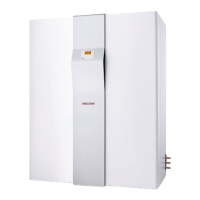www.stiebel-eltron.com LWZ304-404 SOL | 25
INSTALLATION
Installation
26_04_01_0683
Seal the transition from the internal hose to the connector
with the self-adhesive thermal insulation tape supplied.
26_04_01_0684
Pull the external hose and the thermal insulation below it
over the connector.
Tuck the thermal insulation into the outer hose in such a way
that the thermal insulation is no longer visible.
26_04_01_0685
Seal the transition from the external hose to the connector
with the self-adhesive thermal insulation tape supplied.
26_04_01_0686
Secure the external hose with the hose clip to the connector.
26_04_01_0688
!
Material losses
Always cover the air intake and discharge with wire
grilles, and secure the hoses against slippage.
Hose connection panels or wall outlets with hose connection and
grilles are available for hose connections to exterior wall knock-
outs or cellar windows.
5.12 Installing extract air and supply air pipes
Install with the material you can obtain from us or with commer-
cially available folded spiral-seam tubes.
!
Material losses
During installation, ensure that no metal swarf enters
the pipework. However, should this occur, remove this
debris, otherwise the fans may be damaged.
Where the extract air and supply air pipes are routed through un-
heated rooms, they must be thermally insulated. If, when connect-
ing a geothermal heat exchanger, the outdoor air pipe is routed
through heated rooms, this pipe must also be thermally insulated
with vapour diffusion-proof material.
5.12.1 Silencers
Fit silencers as near as possible to the appliance into the extract air
and the supply air flows. Fit a silencer just upstream of bedrooms.
If a room with a high noise level needs to be ventilated, install
additional silencers in the supply air pipe or extract air pipe of this
room to reduce sound transmission to adjacent rooms.
5.12.2 Cleaning apertures
Provide cleaning apertures when installing the air ducts, so
the air ducts can be checked at regular intervals and cleaned
if necessary.
5.12.3 Supply and extract air valves
Ventilation and extract air valves for the living space are available
for wall or ceiling mounting.
When venting the kitchen, ensure that the extract air valve is fitted
as far as possible from the cooker.
!
Material losses
Never link cooker hoods to the ventilation system.
5.12.4 Overflow apertures
Provide suitable overflow apertures since the air is only blown
into living rooms and bedrooms, and is only extracted from un-
pleasant-smelling and humid rooms. For example, fit ventilation
grilles in internal doors or walls, or increase the air gap below
the door (≥8mm) to ensure an unimpeded overflow and thereby
air balancing.

